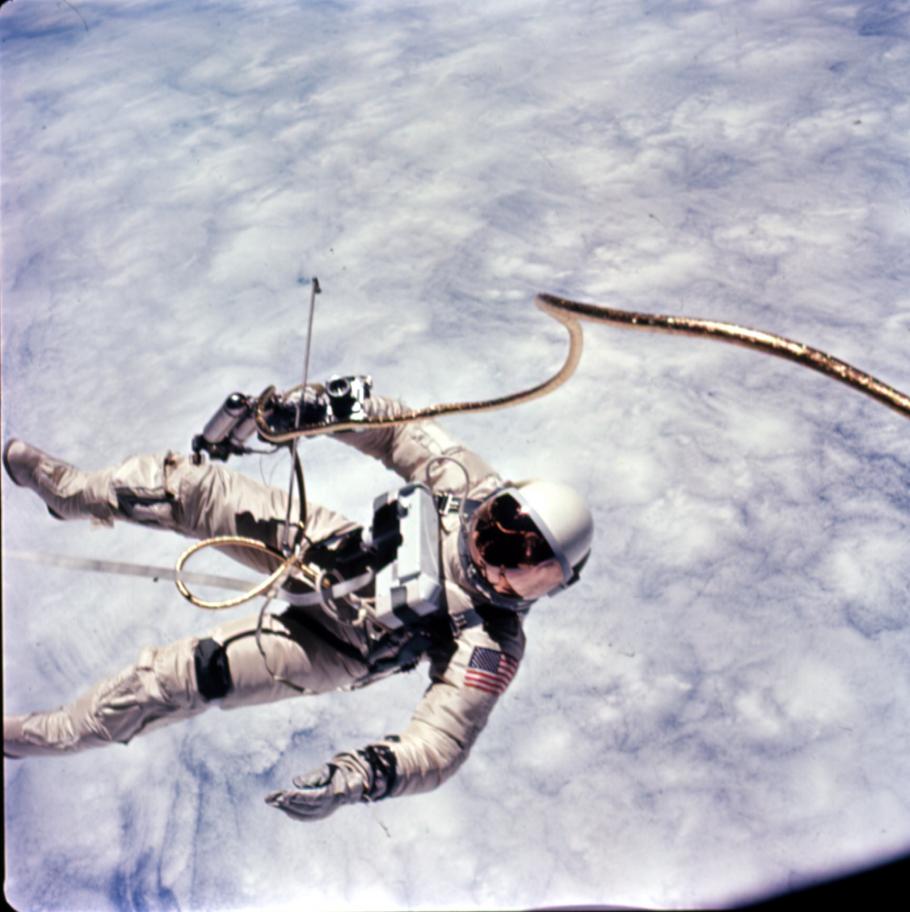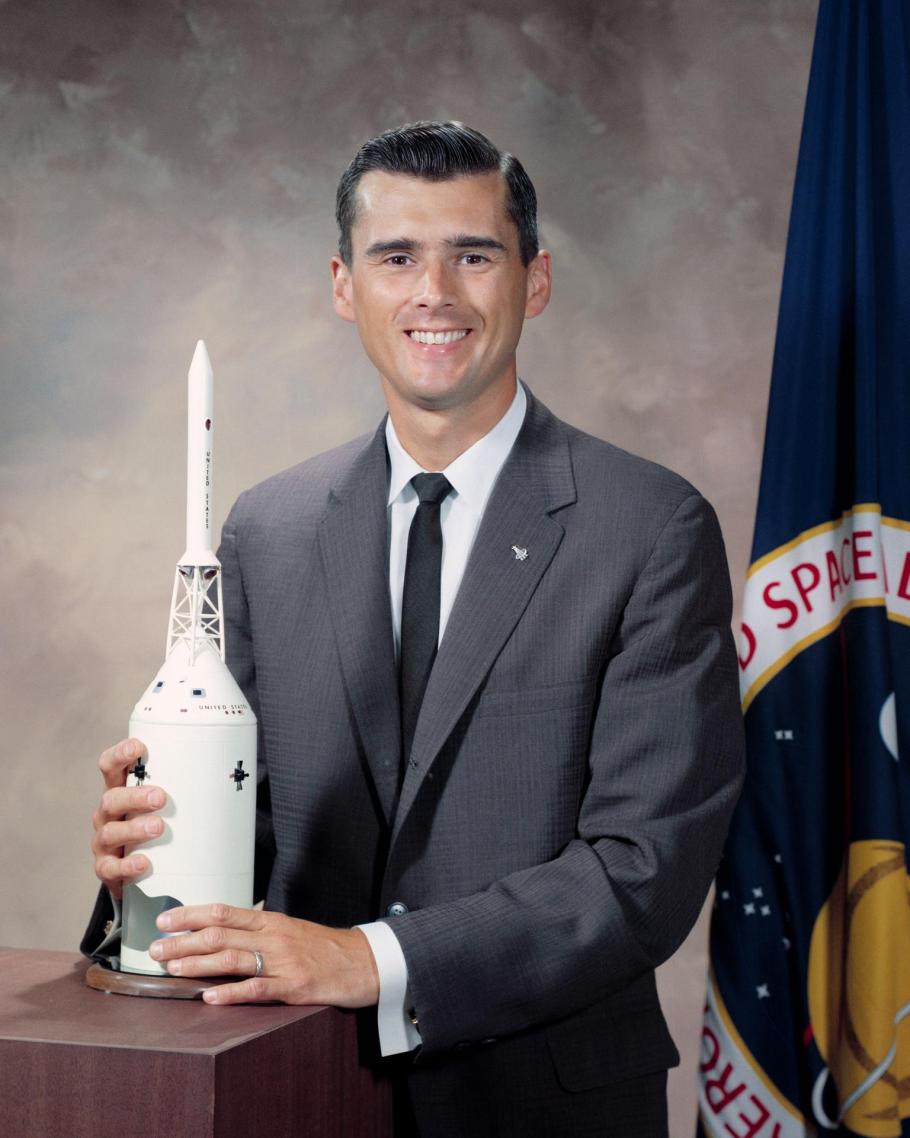Apollo 1
Apollo 1
During a preflight test on January 27, 1967 for what was to be the first crewed Apollo mission, a fire claimed the lives of three U.S. astronauts; Gus Grissom, Ed White and Roger Chaffee. After the disaster, the mission, which has previously been referred to as Apollo-Saturn 204 (AS-204), was officially designated Apollo 1, which was name for the mission the crew had intended to use.
If we die, we want people to accept it.
We are in a risky business and we hope that if anything happens to us it will not delay the program.
The conquest of space is worth the risk of life.
-Virgil I. Grissom, after the Gemini 3 mission, March 1965
The Astronauts
Mercury astronaut Gus Grissom poses with his Mercury space capsule prior to a scrubbed launch in July 1961.
Virgil I. "Gus" Grissom, Commander
Participating in both the Mercury and Gemini programs, Grissom was the second U.S citizen in space in 1961. But that trip, which was nearly identical to Alan Shepard's famed first flight, almost ended in disaster. Grissom’s capsule, Liberty Bell 7, sank after the successful splashdown in the Atlantic, and Grissom came close to drowning. After his brush with death, Grissom went on to command the first piloted two-person Gemini flight in 1965, before being assigned to command the first crewed Apollo mission.
Edward H. White II, Senior Pilot
Edward White, like Grissom, had also participated in both the Mercury and Gemini programs. He was the first American to complete a spacewalk, during the Gemini IV mission. White enjoyed his spacewalk so thoroughly he had to be told several times to return to his spacecraft. He spent nearly twice as long as scheduled on his spacewalk. Like many project Gemini's activities, White's spacewalk was meant to prepare astronauts for Apollo.
Roger B. Chaffee, Pilot
Chaffee was chosen as one of the third group of astronauts selected by NASA in 1963. While he took part in flight control communications systems, instrumentation systems and altitude and translation control systems in the Apollo Branch of the Astronaut Office, Apollo 1 was to be his flight with NASA.
What Went Wrong?
The first problem occurred when Gus Grissom entered into the spacecraft and hooked up to his oxygen supply from the spacecraft. He described a strange odor in the spacesuit loop as a "sour smell". The crew stopped to take a sample of the suit loop, and after discussion with Grissom decided to continue the test.
The next problem was a high oxygen flow indication which periodically triggered the master alarm. The men discussed this matter with environmental control system personnel, who believed the high flow resulted from movement of the crew. The matter was not really resolved.
A third serious problem arose in communications. At first, faulty communications seemed to exist solely between Commander Grissom and the control room. The crew made adjustments. Later, the difficulty extended to include communications between the operations and checkout building and the blockhouse at complex 34. This failure in communications forced a hold of the countdown at 5:40 p.m. By 6:31 the test conductors were about ready to pick up the count when ground instruments showed an unexplained rise in the oxygen flow into the spacesuits. One of the crew, presumably Grissom, moved slightly.
Four seconds later, an astronaut, probably Chaffee, announced almost casually over the intercom: "Fire, I smell fire." Two seconds later, Astronaut White's voice was more insistent: "Fire in the cockpit."
Procedures for emergency escape called for a minimum of 90 seconds. But in practice the crew had never accomplished the routines in the minimum time. Grissom had to lower White's headrest so White could reach above and behind his left shoulder to actuate a ratchet-type device that would release the first of series of latches. According to one source, White had actually made part of a full turn with the ratchet before he was overcome by smoke.
Spacecraft technicians ran towards the sealed Apollo, but before they could reach it, the command module ruptured. Flame and thick black clouds of smoke billowed out, filling the room. Now a new danger arose. Many feared that the fire might set off the launch escape system atop Apollo. This, in turn, could ignite the entire service structure. Instinct told the men to get out while they could. Many did so, but others tried to rescue the astronauts. The intense heat and dense smoke drove one after another back, but finally they succeeded. Unfortunately, it was too late.
A medical board determined that the astronauts died of carbon monoxide asphyxia, with thermal burns as contributing causes. After removal of the bodies, NASA impounded everything at launch complex 34. On February 3rd, NASA Administrator Webb set up a review board to investigate the matter thoroughly. The exhaustive investigation of the fire and extensive reworking of the command modules postponed any crewed launch until NASA officials cleared the command module for crewed flight.
Pictured: The hatch door of Apollo 4, which was configured in the same way as the hatch from Apollo 1.
What Came Next?
In the spring of 1967, NASA's Associate Administrator for Manned Space Flight, Dr. George E. Mueller, announced that the mission originally scheduled for Grissom, White and Chaffee would be known as Apollo 1, and that the first Saturn V launch, scheduled for November 1967, would be known as Apollo 4. The eventual launch of AS-204 became known as the Apollo 5 mission (no missions or flights were ever designated Apollo 2 and 3).



